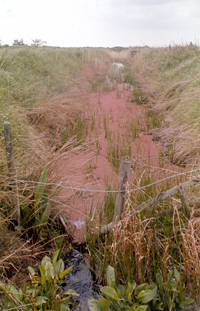Conservation
This species is not threatened. It can be very invasive.
Management

Azolla filiculoides covering a dyke in Norfolk © AC Jermy
As this species is invasive, procedures such as these have been introduced to control its spread:
- it should not be released in the wild
- dispose of garden and pond waste responsibly
- check vehicles, boats, equipment and clothing for plant fragments when leaving infested sites and clean if necessary
Several effective control strategies are used, including:
- Chemical control - spraying with herbicides containing glyphosate or diquat.
- Physical control - plant removal can be effective if repeated frequently.
- Biological control - a small north American weevil, Stenopelmus rufinasus, has been very effective in South Africa against this species and it now occurs in the UK. The weevil is monophagous (larvae and adults only feed on a single species) and so does not itself pose a threat to other species.
Risk statement
- out-competes native plant species
- reduces/blocks light levels - can be harmful to algae and waterweeds
- deoxygenates water killing fish and other fauna
- can block pumps and filters
- can block water bodies and obstruct weirs and other structures, which can lead to an increased risk of flooding
- hazard to children and animals when cover is dense and gives the appearance of solid ground
